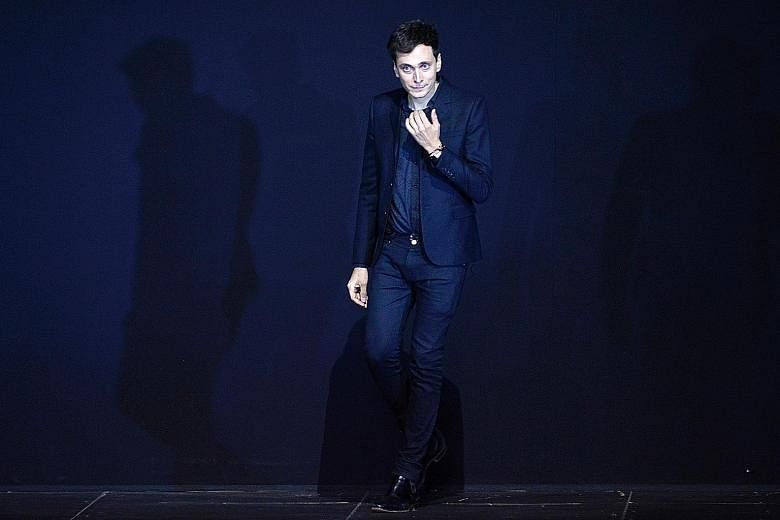NEW YORK • Lately, the Chicken Littles of fashion are reading dire omens into a cluster of design world shake-ups.
Coming soon after changes at the top at Dior, Lanvin and Balenciaga, startling personnel shifts at prominent menswear brands have left some in the industry wandering around dazed, waiting to be smacked with a piece of falling sky.
While this turmoil seems to point to an industry in disarray, the chief cause may be as simple as a generational shift in consumer habits.
Look to the waning fortunes of the suit.
A recap: In February, Stefano Pilati, head of design for Ermenegildo Zegna Couture, parted ways with the Italian luxury goods behemoth - to which he went in 2013 after leading Yves Saint Laurent as creative director for most of the decade before - to pursue "other projects".
The announcement came two days after news broke that Alessandro Sartori was leaving his post as artistic director of Berluti, a label he and luxury goods scion Antoine Arnault (whose father, Bernard Arnault, controls LVMH Moet Hennessy Louis Vuitton) had transformed over half a decade from a high-end cobbler into a sort of Urban Outfitters for the 1 per cent.
Unlike Pilati, Sartori knew where his next pay cheque would come from: He was hired as artistic director of Ermenegildo Zegna.
On the same day Sartori's departure from Berluti became public, the multinational Kering group announced that its high-end Italian tailoring house, Brioni, and the label's creative director, Brendan Mullane, will go their separate ways.
Brioni later appointed a new creative director, Justin O'Shea, credited with transforming mytheresa. com, where his title was former buying director, from a small store in Munich to a luxury e-tailer generating a reported US$130 million (S$174 million) in annual revenues.
Next up was Costume National. Its founders, brothers Ennio and Carlo Capasa, citing the age-old conflict between art and commerce, announced they were exiting the hipster-rocker-minimalist brand after conflicts with Asian investment firm Sequedge, which had become a minority shareholder in the company in 2009 before exercising its option to buy it this year.
Kering then said Hedi Slimane, creative and image director of Saint Laurent, was leaving the storied label he had roused from torpor with his singular take on Los Angeles rocker chic.
Replacing him was Anthony Vaccarello, a quiet Italian-Belgian designer lately of Versus Versace.
Late last month, Salvatore Ferragamo announced that its talented and low-key creative director, Massimiliano Giornetti, was ending his stint as creative director of the family-run Italian label he joined more than 15 years ago.
Just yesterday, Calvin Klein Inc announced that its main creative director Italo Zucchelli was leaving the company, together with Francisco Costa, its women's creative director.
What the anxious industry chatter seemed to obscure was the positive news that, despite slowed growth, the luxury goods trade remains robust and that, as much as anything, tectonic shifts in consumer habits were the likely triggers of change.
According to Mr Thomas Chauvet, a luxury goods analyst in London at investment bank Citi, overall sales in the menswear industry will stay strong, thanks to the newfound embrace of fashion by men.
To the electronics and gear that traditionally served as cornerstones of male buying habits, you can now add moisturiser and US$400 boxer shorts.
Even as China slumps and India continues to put on last-ditch resistance to the incursion of Western capitalists, nimble industry players have begun to focus less on geography than demographics.
Thus, the ruptures and personnel shifts that shook up major design houses were, in some ways, to be expected, said Mr Raffaello Napoleone, chief executive of Italian trade group Pitti Immagine. "The moment is right for everyone to alter his approach," he said.
Not only is the era of the star designer on the wane, but a newly informed generation of consumers now coming to maturity also already knows what it wants.
By some estimates, a cohort born at the end of the last century and in the early years of the current one could grow to 60 million by the end of the decade.
Technologically fluent and imbued with the entrepreneurial ethos that is a hallmark of the start-up era, those consumers - quite a few of the male ones - are so accustomed to pursuing their careers in their skivvies that a traditional suit seems about as relevant to them as a toga.
That helps explain why tailoring houses such as Brioni find themselves suddenly scrambling for relevance.
Instead of depending on the traditional suit and durable basics to carry a brand, menswear designers may win over the 21st-century generation by stimulating appetite for accessories and separates and seasonally shifting objects of desire, as the Yoox Group's e-tailing site, Mr Porter, has done.
NEW YORK TIMES

